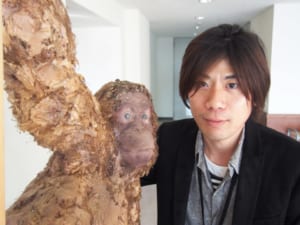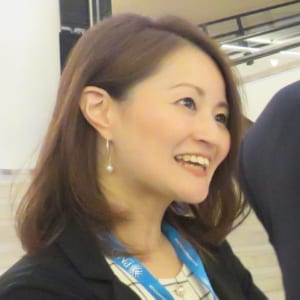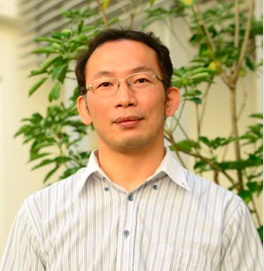Researcher's "hypothesis" is the source of knowledge (Part 2)
2019.12.21Session Report of the 8th Main Conference of the Association of Hyperdifferent Fields
Exploring the Origins of Knowledge - Can Crossing Disciplinary Barriers Generate Valuable Ideas [PART2].
Session Partner: Focus Systems, Inc.
<Speakers
 Assistant Professor, Department of Genome Evolution, Division of Genomic Cell Research, Primate Research Institute, Kyoto University
Assistant Professor, Department of Genome Evolution, Division of Genomic Cell Research, Primate Research Institute, Kyoto University
Mr. Masanori Imamura
Born in Takaoka City, Toyama Prefecture. Doctor of Medicine. After spending time as a student at the Faculty of Science, Kanazawa University, Nara Institute of Science and Technology, Graduate School of Medicine, Kyoto University, and Mitsubishi Chemical Life Science Institute, he worked as a Project Assistant Professor at Shiga University of Medical Science, Project Assistant Professor at Keio University School of Medicine, and a Visiting Researcher at RIKEN before assuming his current position in 2013. He has been working on human evolution and postnatal development from a stem cell perspective. He has received Life Technologies Japan Award (18th), On-Chip Biotechnologies Award (24th), SCREEN Holdings Award (29th), and L-RAD Award (36th) as the LIVERNESS Research Fund.
Laboratory websitehttp://www.pri.kyoto-u.ac.jp/sections/molecular_biology/member/imamura.html
 Associate Professor, Faculty of Education, Shiga University / Director, Eve Care Co.
Associate Professor, Faculty of Education, Shiga University / Director, Eve Care Co.
Masako Ohira
Completed the doctoral course at Osaka University Graduate School of Medicine in 2011. In the same year, he became a researcher at Nagaoka University of Technology's Center for the Development of Top Runners in the Fusion of Industry, Academia, and Government. He became a lecturer at the Faculty of Education, Shiga University in the same year and an associate professor at the same university in 2015. Since his graduate school days, he has been consistently engaged in research on stress evaluation using hormones in saliva. In recent years, he has been engaged in research and development of methodologies for stress assessment that do not use saliva, such as psychological stress assessment using biochemicals derived from body tissue fluid, nails, and hair. D. in Medicine.
 Project Associate Professor, Department of Tissue and Cell Design, Osaka University Graduate School of Medicine
Project Associate Professor, Department of Tissue and Cell Design, Osaka University Graduate School of Medicine
Technical Advisor, MyOrridge, Inc.
Mr. Kazunari Minami
D. in March 2003 from the Department of Neurophysiology, Division of Biophysics, Department of Biological Sciences, Faculty of Science, Kyoto University. He has developed low-cost and stable cell differentiation culture media and cell culture methods using novel compounds, and is conducting research and development for the mass production and stable supply of high-quality cardiomyocytes from iPS cells. Using this novel culture technology, he aims to lay the foundation for practical use of higher-order cellular tissues. 2016, he became a technical advisor to MyOridge, Inc. a bio-venture for mass culture of iPS cell-derived cardiomyocytes. 2017, he became a Project Associate Professor at Osaka University Graduate School of Medicine, Department of Collaborative Research in Tissue and Cell Design.
.
 Representative Director, President and COO, Liverness, Inc.
Representative Director, President and COO, Liverness, Inc.
Shuichiro Takahashi
D. (Life Sciences), Graduate School of Frontier Sciences, The University of Tokyo. He has been involved in RIVANESS since its establishment. After completing his graduate studies, he continued his research activities as a faculty member at the University of Tokyo, while at the same time he established a research institute at RIVANESS and built the foundation of its research and development business. He devised the business model of "Liberness Research Grant," a unique research grant, and "L-RAD," a database of unutilized research ideas, and has initiated many open innovation projects involving industry, academia, and education.
Researcher's "hypothesis" is the source of knowledge (Part 2)
(Ohira)
I was in the agriculture department doing genetic research with Drosophila. I wanted to do something closer to people, so I went to medical school and spent my entire career until I became a doctor. I was in a field close to public health, but I began to wonder why the number of healthy people has not increased at all, despite the fact that the world is full of information about how to make people healthier if they follow this kind of lifestyle. I thought, "I want to create something that makes people healthy," and chose the engineering department as my postdoctoral fellowship. But then I went to the Faculty of Education. I chose the Faculty of Education because I felt the importance of communicating this issue. When I thought about who it was important to communicate to, I thought it was children rather than the elderly who are getting sick. But I do not have a teaching license. Therefore, I thought that by communicating the importance of health to students who are going to become teachers, they would be able to spread the message to many more generations to come.
I call myself an applied health science specialist, but since my background is quite diverse, I would like to integrate disciplines such as biology, medicine, psychology, engineering, and education to create a single specialty.
There is one thing I always try to keep in mind when setting up a research agenda. That is to use different approaches and methodologies from others as much as possible. To illustrate this, let me compare research to digging a hole. Everyone is digging a hole for the treasure. To reach the treasure as quickly as possible, you need to dig a different hole with a different tool. The "different hole" here is the "newness of the cut" and the "different tool" is the "newness of the methodology. What we have done with this approach is research on sleep quality. Recently, many companies and researchers have been trying to develop devices that can easily measure sleep quality, but they have not been very successful. So I began to think that I wanted to establish an index that could properly evaluate sleep itself. In fact, I have created a device that can continuously collect body fluids while you sleep. As a result, I found a substance that is secreted immediately after waking up. By measuring this substance, it would be possible to easily determine the quality of sleep, and regardless of age. Although it is an advantage to be able to do something different from others by utilizing my diverse background, I have received various comments such as "I don't really understand what you want to do," "You don't have any expertise," and "You are doing too many things. However, for myself, I have a consistent worldview. That is, I want to create a world where people can be healthy without having to work hard.
Currently, we are working on two axes: the first is to induce health in the surrounding environment, in other words, to create a space where people can become healthy without doing anything. To this end, we are investigating the effects of various environmental factors on people, but it is meaningless if we cannot accurately evaluate the state of a person in the first place. In this sense, we are putting considerable effort into research and development of new methods to evaluate the human condition, such as using saliva to evaluate sleep, in other words, the evaluation index itself.
The other thing, which also motivates me to come to the Faculty of Education, is the development of communication methods. I was an amateur in this field and had no idea how to do it, so I went to various academic conferences and suddenly contacted a professor who was doing something interesting and asked him to talk about it, but I hadn't found a method that seemed to fit. But actually, I am very glad that I attended this two-day conference, because I found a method that I thought would be good.
Last but not least, in conducting this kind of research, it is necessary to examine whether people are really changing over the long term. For this purpose, we have been conducting research to create an index that can evaluate the effects using hair and nails. Two months ago, I launched the first venture company at Shiga University, EveCare Co. I also want to implement this method in society, but in the end, the purpose of this kind of activity is to accelerate individual research necessary to create a "world of health without doing anything". Best regards.
(Takahashi)
Mr. Imamura, please.
(Imamura)
My name is Imamura from the Primate Research Institute, Kyoto University. I am sure that everyone has an image of Ai, the smart chimpanzee, or a trip to the Amazon, but my group is conducting research using iPS cells in order to understand human development and evolution. When the general public hears the word "iPS cell," they think of regenerative medicine or drug discovery, but this is just a technology. These cells are "a source of cells to obtain cells needed for a certain purpose. So, in fact, there are many possible uses.
What we want to know is an old, fundamental, and simple question: "What is a person? Clearly, there are significant differences between us, humans, Homo sapiens, and the so-called primates. Not only in language and intelligence, but also in medical characteristics. For example, chimpanzees, which are said to be the closest to humans, do not get cancer nearly as often as we do. It is also known that they do not show pathological symptoms of Alzheimer's disease. But on the contrary, they are known to be prone to cardiovascular diseases. In the same way, the susceptibility to disease varies from person to person. We would like to know what mechanism produces such peculiarities. But we cannot conduct human or genetic modification experiments on humans or chimpanzees to find out. However, it is possible to create human and chimpanzee iPS cells. For example, it is possible to create chimpanzee and human iPS cells, and then induce neural induction in the same way to examine the differences in development and gene function between the two species. In other words, these cells are actually a good tool for evolutionary research. With this in mind, we are trying to demonstrate the reason why we are human by using primate iPS cells.
Furthermore, I believe that iPS cell research and primatology are actually in very similar situations. These fields have advantages in that Japan has great strengths in these fields. However, they also have similar disadvantages. For example, as I mentioned earlier, the purpose of using this technology is too much focused on regenerative medicine and drug discovery. If this is the case, there will be situations in which the inherent potential of these cells cannot be utilized. This situation is similar to primatology. It has a long history in Japan, but because too much attention has been paid to ecological and behavioral research, it is difficult to conduct research using new approaches. I am trying to create a new academic system by combining the strengths of these two fields.
I moved from the School of Medicine to the Primate Research Institute in the winter of 2013 with this research theme in mind, I went through a dark period right away. I applied for research funding but could not get it. I had changed my research theme so drastically that I had no results or achievements. In the midst of all this, the first grant I received was the LIVERNESS Research Grant. From there, I received a research grant about once a year until the lab started to get on track. Of course we were grateful for the money, but we also received support for the start-up of the lab in various ways, such as the loan of a microscope for one year. I also needed to disseminate information in order for people to understand my research, and they invited me to various events, or conversely, they helped me organize events. As a result, my research got on track, and as data began to emerge, I was able to get funding from the Grant-in-Aid for Scientific Research and other research budgets. I have now received four "leave-a-liverness" research grants, and now I think I have received too many, so now I think I have received a "leave-a-liverness" research grant. Our goal is to create new fields, and we are working on various projects to expand the possibilities of iPS cells and primatology, so if any students or researchers are interested, please contact us.
(Takahashi)
Thank you very much. It's kind of strange that the corporate side would support this kind of seemingly basic research.
(Imamura)
It's true. I am completely basic and have no achievements. I think that supporting the seed part is a good point of the Liberace Research Fund, which is not so visible, and is different from other types of support.
(Takahashi)
Yes, I think it is. I think it is very important to diversify the budget providers. While it is important to obtain a large national budget, it is difficult to challenge start-up research projects that require consensus from the taxpayers, such as the Grant-in-Aid for Scientific Research, because the budget is derived from taxpayers' money. However, I think it would be very interesting if the industrial side could expand the diversity of academia through a system like the Liberal Arts Research Fund. Also, as Dr. Ohira mentioned, connecting with people in different fields is a great way to expand one's research. I believe that these three professors have developed their hypotheses through encounters with various things as they have been involved in such a variety of activities. So, I would like to ask the three of youI would like to hear what you are doing to create hypotheses, what you value, if you have such a thing.First of all, Dr. Minami, can you tell us?

